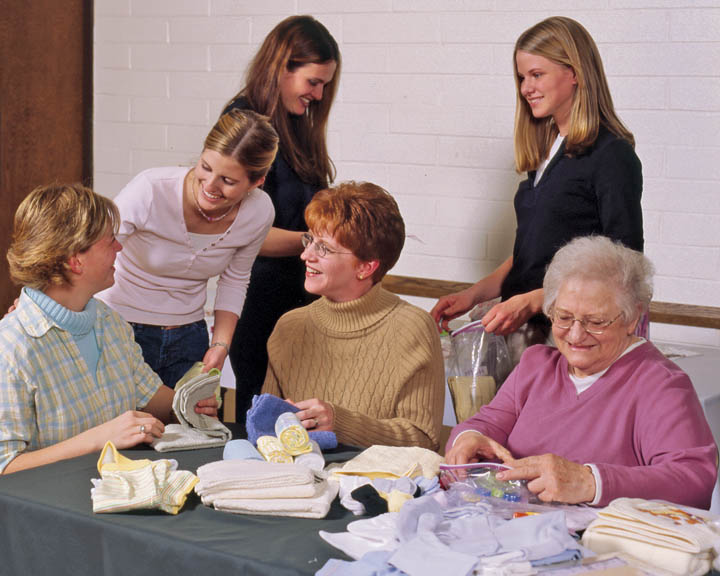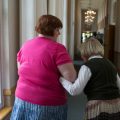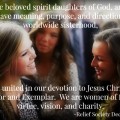 Relief Society is the official women’s auxiliary for The Church of Jesus Christ of Latter-day Saints. Members of this church are sometimes called Mormons because they accept the Book of Mormon as scripture, a book that testifies of Jesus Christ and is a companion book to the Bible.
Relief Society is the official women’s auxiliary for The Church of Jesus Christ of Latter-day Saints. Members of this church are sometimes called Mormons because they accept the Book of Mormon as scripture, a book that testifies of Jesus Christ and is a companion book to the Bible.
The official handbook for The Church of Jesus Christ of Latter-day Saints explains the purpose of Relief Society:
Relief Society prepares women for the blessings of eternal life by helping them increase their faith and personal righteousness, strengthen families and homes, and help those in need. Relief Society accomplishes these purposes through Sunday gospel instruction, other Relief Society meetings, visiting teaching, and welfare and compassionate service. (See Handbook 2: Administering the Church.)
Relief Society began in 1842 when the women of the church told Joseph Smith, their first prophet and president, that they wanted a woman’s organization similar to those that were fashionable all around the country. He told them he had a better plan for them, one planned for them by God Himself and lost in the Great Apostasy. He helped them organize the Relief Society and told them the church had not been fully organized until the Relief Society began. It was to become a critical part of God’s plan, it’s motto, Charity Never Faileth, guiding its members in their work.
Julie B. Beck is the current president of the world-wide Relief Society. This places her in leadership over millions of women in diverse settings. Local branches of the organization have local leaders who report to stake (regional) leaders. Leadership of the Relief Society is also held by women at all levels.
Julie Beck explained:
We work in partnership with priesthood leaders, who hold keys which give them authority to preside in the name of the Lord. We operate in the manner of the priesthood—which means that we seek, receive, and act on revelation; make decisions in councils; and concern ourselves with caring for individuals one by one. Ours is the priesthood purpose to prepare ourselves for the blessings of eternal life by making and keeping covenants. Therefore, like our brethren who hold the priesthood, ours is a work of salvation, service, and becoming a holy people. (See Julie B. Beck, Relief Society: A Sacred Work.)
The Relief Society has a number of elements that help it carry out its purpose. Each Sunday Mormons hold church for three hours. They have a standards worship service, and two sessions of classes. One class is Sunday School, with men and women together. For the final classes, men and women meet separately. The women have Relief Society, where they discuss the gospel from a woman’s point of view. They learn how to apply the gospel in their everyday lives and lessons are personalized to the individual needs of the class. Classes are taught by women who are called (chosen) to teach.
In addition, Relief Society groups hold periodic meetings on other days. Some small groups form based on special interest, such as literature, self-reliance, or parenting. If a woman has an interest in forming a group, she can talk to her Relief Society leaders, which means the groups can have endless diversity. Once a month most Relief Societies also hold larger classes for all women. These are often a combination of spiritual and practical knowledge. Over the years I have learned some of the following skills in various Relief Society meetings: car repair, plumbing, cooking inexpensively, sewing, family history, gardening, languages, home education, blogging…the choices are as varied as the women who belong to the organization. In addition to lessons, many Relief Society meetings also involve humanitarian work.
Service is, of course, a primary component of the Relief Society organization. One popular part of the program is the literacy program. The literacy leader must be a woman, since she must be a member of the Relief Society, although men may receive the training and may also teach under the direction of the female leader. Literacy takes many forms, based on the needs of the individual congregation. If someone needs to learn to read, he or she may be taught by a private tutor. If there are multiple students who want to learn to read, a class is organized. Once students have completed the class, they can teach others to read, serving as both a teacher and a role model for students, who will be able to have a teacher who has been there.
During my time as literacy leader, I oversaw an English as a Second Language program and a citizenship preparation class. We also organized a blogging club, since in today’s world, blogging is one type of literacy. Other programs might help parents raise readers, teach journaling or personal history writing, improve computer skills, or conduct a literary book club. Some conduct homework help programs for children. Each congregation chooses the focus that best suits the needs of its members.
Another service program carried about by the Relief Society is Visiting Teaching. Women, working in pairs, are assigned several women to visit each month. They develop a friendship with those they visit and, when that woman needs help, she has two people she can call on. As a person who moves often, I can testify to the value of a visiting teacher. The first time I lived far from any family was pretty overwhelming. One day I needed help but because I was new, I just didn’t feel I knew anyone well enough to “bother” them with a request for assistance. As I stood in my kitchen, worrying about what to do, I noticed on my refrigerator a small poster with the names and numbers of my new visiting teachers, with a plea to call them first on the bottom of the note. Relieved, I picked up the phone and reached a visiting teacher who was thrilled that I had felt comfortable enough to ask her for help.
Years before that, my father was diagnosed with a brain tumor. His emergency surgery was being held some distance away and I needed to be there. However, I was in the process of moving out of state and my husband had already gone ahead to get his new office in order and to find a home for us. I had no idea how to organize the millions of details of my suddenly complicated life. To make matters worse, my visiting teacher (I only had one at the time) had just moved and I hadn’t been given a new one yet. Then a knock came at my door and three women stood there. They were the women I was assigned to as a visiting teacher. They had heard of my plight and on discovering I had no visiting teacher, they had decided to turn tables and be my visiting teachers for the last month I would be living there. They had already set up transportation for my children so they could get to their meetings and activities and found child care for me while I was out of town. When I returned to retrieve my children, dinner was waiting for me and someone had even given the children their allowances since I was gone on allowance day! Visiting teaching builds a web of friendships that can be a lifesaver, sometimes literally, since an elderly woman living alone will have someone checking on her regularly.
Each Relief Society has a compassionate service leader. This woman oversees all the service needs for the women—and sometimes the men—in the congregation. If the visiting teachers become aware of a need that is too big for them to handle alone, they pass the information on to the compassionate service leader to handle. That leader will ask for volunteers to step in and help out. Typical service includes bringing in meals to families that are sick or grieving, cleaning homes when a family is moving out, picking up children in an emergency, checking on an elderly person daily, and taking people to doctor appointments.
Next week we’ll look at how Relief Society impacts the Mormon view of womanhood.
About Terrie Lynn Bittner
The late Terrie Lynn Bittner—beloved wife, mother, grandmother, and friend—was the author of two homeschooling books and numerous articles, including several that appeared in Latter-day Saint magazines. She became a member of the Church at the age of 17 and began sharing her faith online in 1992.





